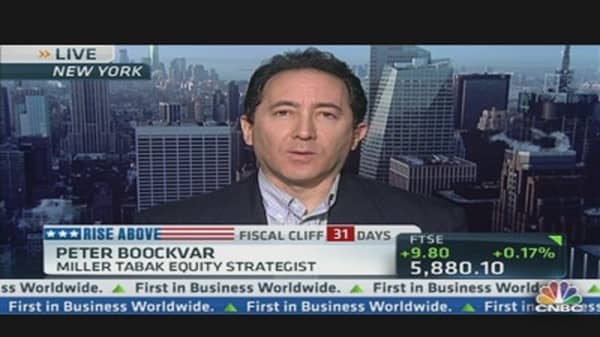Despite an array of reasons to avoid government debt, investors are continuing to pile into Treasurys—fiscal cliff or no fiscal cliff.
Reversing a six-month trend, U.S. securities topped corporate bonds in November, even amid all the wrangling over the deficit-reduction talks and the divisive presidential election.
Driving the trade was an aversion towards riskier assets like stocks and commodities, as well as a feeling that with U.S. growth slow and much of the global economy likely to be even slower, Treasurys remain a premier place to be.
"Just the general risk-on risk-off type of atmosphere — there's so much uncertainty out there that it's pretty difficult to try to guess what's going to happen," said Kim Rupert, managing director of global fixed income analysis at Action Economics in San Francisco. "A lot of people are just parking their cash now into Treasurys."
That safe-haven bet has come in the face of some fairly daunting obstacles.
The U.S. economy remains at substantial risk of an early 2013 recession, particularly if negotiations over the "fiscal cliff" are not fruitful.
Congressional leaders are squaring off in Washington, trying to find a way to prevent severe tax increases and spending cuts from automatically going into effect in January. Should no solution be reached, economists fear that the austerity measures will sap any chances at growth. (Read More: States Likely to Get Hammered If 'Cliff' Talks Fail)
But rather then dim faith in U.S. debt, the tumult has only made investors hungrier for its relative safety.
"Deflation is still the big thing," said Robert "Hap" Sneddon, president at Canadian portfolio manager CastleMoore, whose proprietary model has seen Treasurys surge to the fourth-best — previously 11th — out of 16 asset classes since mid-September.
Sneddon said the move is symptomatic of a trend by investors towards protecting capital rather than seeking outsized gains through risk.
"People will be happy if you can deliver 5 or 6 percent on long Treasurys over a given year," he said. "Clients are happy. Expectations have been reduced."
In a recent analysis of government debt, Bank of America Merrill Lynch recommended clients buy 2-year Treasurys, and cited four reasons for the strategy:
- Financial crisis-era unlimited guarantees on noninterest-bearing bank accounts from the Federal Deposit Insurance Corp expire at the end of the year. Those funds — about $1.6 trillion — are likely to find a new home, and short-dated Treasurys are one likely destination.
- The Federal Reserve's Operation Twist also concludes at the end of the year. Consequently, the central bank will not be selling short-dated securities, which should push prices higher and yields lower.
- The Fed also will be growing its $2.9 trillion balance sheet through the third round of quantitative easing, with the increase in reserves pushing the funds rate lower and benefiting two-year notes.
- Interest rate swap operations now must go through clearing houses, and participating parties would be likely to use short-dated Treasurys as collateral.
"Even though many of these factors are macro in nature and have been known for a while, we believe they are not priced into the front end of the Treasury market yet," BofA rates strategist Priya Misra said.
Foreign demand has remained strong for U.S. debt.
In addition to the heavy Fed buying, China has kept its holdings steady around the $1.16 trillion mark, while Japan has upped its holdings by 15 percent this year to $1.13 trillion. Foreigners in total hold about $5.46 trillion of American debt, which also has the advantage of continuous supply over many of its foreign competitors. (Read More: Is China Coming to a City Near You?)
Even a debt downgrade last year from ratings agency Standard & Poor's has failed to make a dent in the Treasurys trade. The benchmark yield then was 2.47 percent and has tumbled since, reflecting the greater demand.
Benchmark 10-year notes are yielding about 1.61 percent. Comparable debt at the municipal level is yielding 1.47 percent, while corporates are at 2.09 percent.
"The overriding fear that at some point yields are going to go higher remains in place. It's just not happening anytime soon," Rupert said. "You stay invested in Treasurys until the bottom falls out — and don't be the last guy out."





